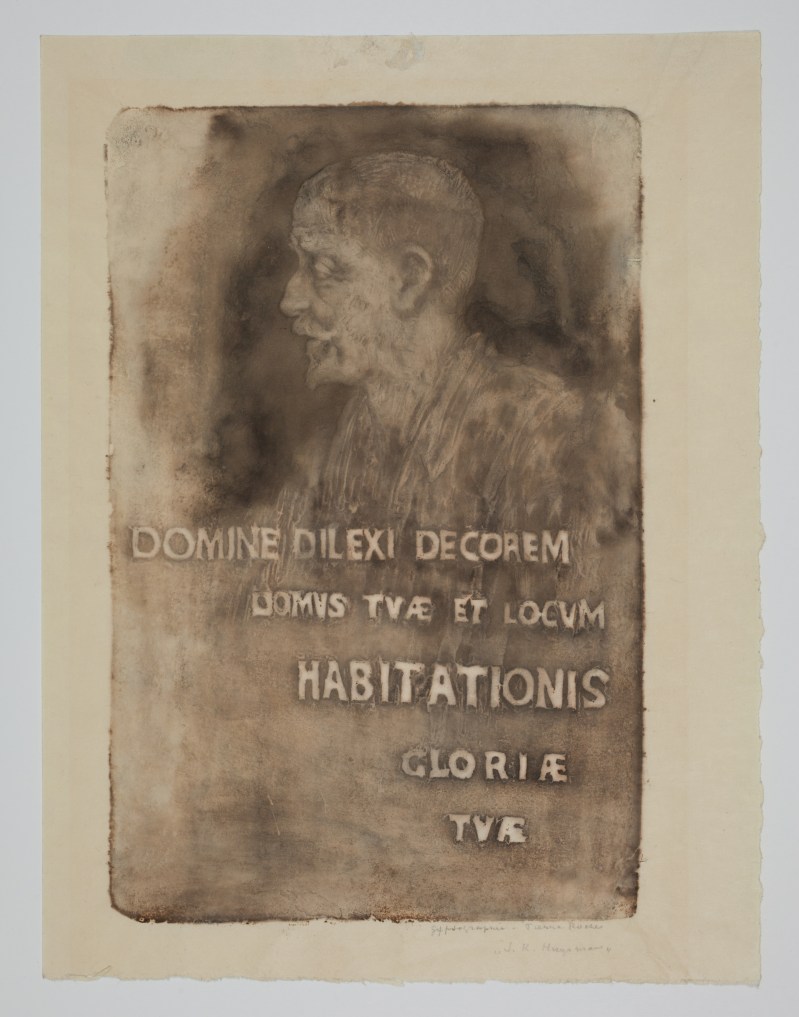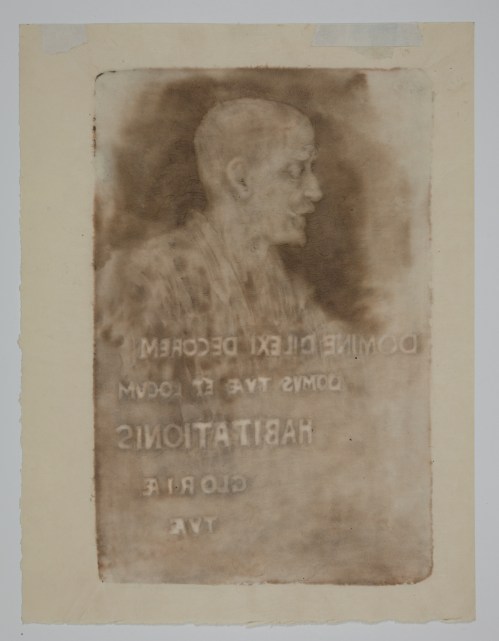Pierre ROCHE: Portrait of Joris-Karl Huysmans - 1901
SOLD
Gypsograph, 226 x 149 mm. Massignon 4 (Part II Catalogue des gypsographies, Section 8 Portraits).
Superb impression printed in shades of brown on Japan paper, inscribed in pencil gypsographie, signed Pierre Roche and titled « J. K. Huysmans » bottom right. In very good condition. A tiny area of surface abrasion in the upper margin. Usual small margins (sheet: 264 x 200 mm).
An extremely rare impression: Louis Massignon indicates an edition of only three impressions. One of them is reproduced in black and white in his catalogue.
Pierre Henry Ferdinand Massignon was a sculptor, painter, engraver, medallist and ceramicist; his artist’s name, Pierre Roche, was the name of his grandfather. He invented a new technique and gave it the name of gypsographie [gypsograph], a sort of « new sculpture », according to him, that made it possible to « join the work of the sculptor to the wok of the colour printmaker, in order to recreate, in prints, an effect akin to Classical polychromy ». (« La gypsographie et son avenir », in Pierre Roche - Estampes modelées et églomisations, p. 61 ff, our translation).
The gypsograph technique consisted in creating a cast, applying coloured inks and printing an impression by pressing paper against the cast. « The principle, » according to Pierre Roche, « is simple to understand, more difficult to implement in practice ». The plaster used for the cast was fragile and porous, and as such required a special type of ink as well as very careful printing: it was necessary to apply pressure in a progressive and uniform way in order to avoid breaking the mould.
« However, » added Pierre Roche, « As there is hardly any process that does not derive some of its interest from its difficulties, even its imperfections, the grain of plaster, its relative flexibility and its permeability gave a unique character to the prints thus obtained […] ». Gypsograph is characterised by the absence of printed lines: the image is created only through the hollows and reliefs that the sculptor-printmaker needs to imagine step by step as the cast is created. Each impression, printed by hand, is unique, and editions remain very limited as a result.
Pierre Roche was a close friend of Joris-Karl Huysmans and created the frontispiece for Huysmans’ 1898 novel La Cathédrale at the writer’s request. The same year, he sculpted a bust of the writer, and a plaster copy was immediately exhibited at the Salon. The bronze, which Roche finished two years later, was gifted to Huysmans, who received it enthusiastically. This bronze, the only one, was bought in 2018 by the Petit Palais museum. It is currently on display in the exhibition dedicated to Pierre Roche, which is being held at the Petit Palais from 10 March to 11 September 2022, "L'esprit Art Nouveau. The Pierre Roche donation at the Petit Palais".
The online catalogue entry for that sculpture indicates that « Pierre Roche, who was more comfortable with decorative creations, had very limited interest in portrait, and only ever made them for his close friends: as a result portraits by him are very rare. In that genre, Huysmans’ bust is without a doubt Roche’s masterpiece. The portrait is extremely realistic, when compared to photographs of Huysmans around 1900; it is also very sensitive and lively: the expression on the face is both thoughtful and animated, as if capturing a moment in a friendly conversation. Not only is the bust very expressive, but its technical mastery is also to be noticed. When he received it at Ligugé, Huysmans greatly admired the quality of the patina. Pierre Roche, with the curiosity of an artist and inventor, was very interested in the effects that could be achieved thanks to different tones of patinas. »
The gypsograph of Huysmans’ portrait, made in 1901, shows the same level of care for different tones, apparent in the choice of a colour that could recreate the atmosphere most closely associated with the writer. The profile is very close to that of the bust and is completed by some quickly sketched clothing and, underneath, in large white capital letters, verse 8 from Psalm 26, which Huysmans quotes as an epigraph to La Cathédrale: « Domine, dilexi decorem domus tuae, et locum habitationis gloriae tuae. » [Oh Lord, I love the house where You dwell, the place where Your glory resides].
Reference: Louis Massignon: Pierre Roche - Estampes modelées et églomisations. Aquarelles estampées tirées sur plâtre, gypsographies encrées et tirées sur plâtre, gypsotypies tirées sur cuivre ou sur acier, églomisations sur verre, mica, papier, parchemin - catalogue de ses œuvres, 1935.




